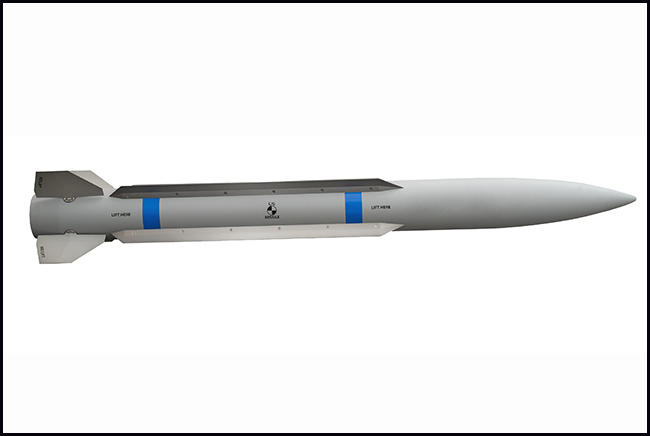
Raytheon is proposing its new Peregrine missile as a complement to the AIM-120 and AIM-9X in the air-to-air role. The missile would be half the size and weight of the previous missiles, but with more range, increasing the number of shots for each fighter that carries it. The company is funding development for now. Raytheon courtesy image.
Raytheon is developing the “Peregrine,” a new medium-range air-to-air missile that is half the size of current dogfight missiles but offers greater speed and longer range. The weapon would allow Air Force fighter jets to double or triple their munitions loads, sharply increasing the number of shots they could take in a single mission.
The Peregrine is being developed with Raytheon’s own funds, according to Mark Noyes, a senior business development official in the company’s air warfare systems sector. While Raytheon is not developing the missile to meet a specific Air Force or Navy requirement, the Peregrine is meant to meet the Pentagon’s need for large numbers of affordable weapons that still “overwhelm an enemy,” Noyes said.
The weapon is expected to measure just under 6 feet long and 150 pounds, less than half the weight and length of Raytheon’s AIM-120 Advanced Medium-Range Air-to-Air Missile and AIM-9X Sidewinder that fly on fighters across the Defense Department.
“We’re able to take the best of both of those missiles and, based on what we see as the customer’s requirements and gaps, we are combining them into this new missile,” Noyes said.
Peregrine “combines the range and the autonomy of the AMRAAM with the maneuverability characteristics of the AIM-9X” with extreme maneuverability as it approaches its target. The weapon will cost “significantly less” to buy and maintain than the AIM-120 or AIM-9X, and is faster to develop, thanks to ready-made components and additive manufacturing.
The Peregrine will have a multi-mode, autonomous seeker that includes infrared imaging. It uses a “new, high-performance propulsion system” to boost speed, Noyes said. He would only characterize the missile’s range as “from visual range to within medium range” but said Peregrine is a supersonic munition.
The all-weather, day or night weapon has a blast fragmentation warhead and a “new lightweight airframe and high-performance modular control system” that allows for highly accurate targeting, Noyes said.
He added that the Peregrine will fit into the current air-to-air weapon stations on all fourth- and fifth-generation aircraft pylons, and can sit in the weapons bay of the F-35. Noyes declined to comment on whether it will fit in the F-22’s weapon bays.
Peregrine is meant to complement, not replace, the AMRAAM and Sidewinder. The AIM-9X will still be the world’s best close-in dogfighting missile, Noyes said. It remains to be seen if the Peregrine will match the Sidewinder in close-range maneuverability.
Raytheon declined to say when the Peregrine could be ready for production or which components of the previous missiles would be reused.
However, the company wants to collaborate with the military services before committing to a final configuration to “make sure they resonate with the process and the direction we’re going in on the design of this missile,” Noyes said.
Lockheed Martin in recent years has been developing a similar concept, called the “Cuda,” which would offer comparable size and weight. In June, the Air Force announced that Lockheed is also developing an AMRAAM replacement called the AIM-260. The latter missile would be the same overall size as AMRAAM, but with much greater range, maneuverability, and less vulnerability to jamming.